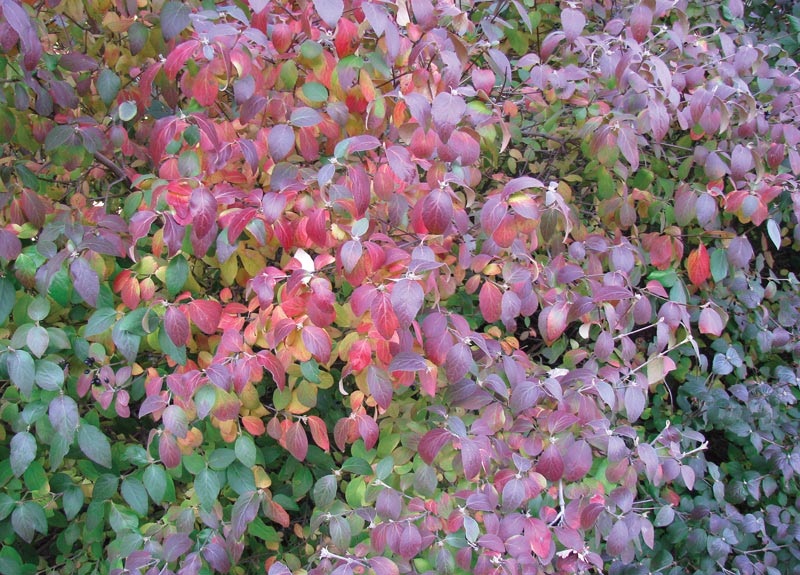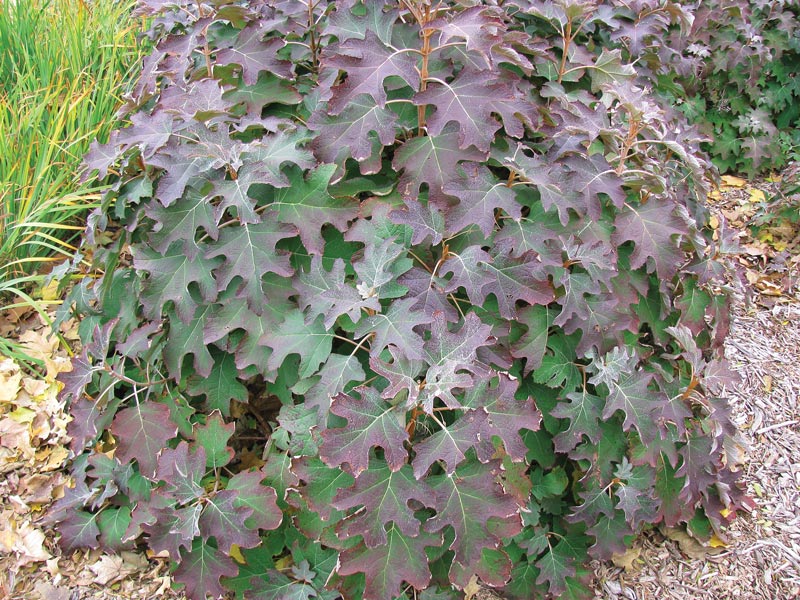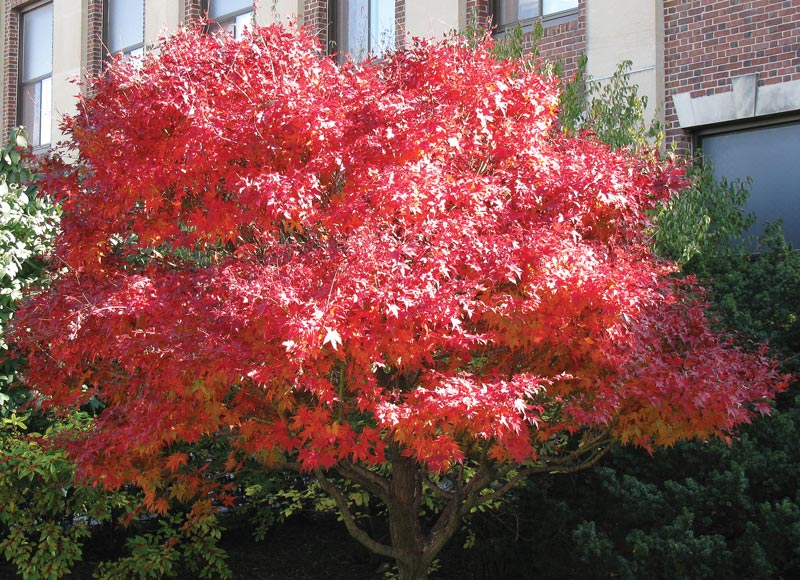
Blackhaw is just one of many outstanding shrubs for adding texture and color to the golfscape. Photos by John Fech
A common goal in the world of landscaping golf courses — or any landscaping, for that matter — is the creation of four-season color.
Just about any competent golf course architect, landscape architect or horticulturist will strongly emphasize the importance of the other design considerations such as drainage, right plant/right place, gradation, scale, texture, mass/void, erosion prevention, soil amendments/adjustments, sun and shade exposure, slope, winter hardiness, disease resistance, planting diversity, eventual size, and so on. But without a doubt, the influence of color on the golfer is most impactful.
Having golfscape appeal in various seasons — spring blooms of assorted colors, summer green textures, winter bark/fruit/habitat (great when cast against the snow) — offers tremendous value. Yet far too often, fall becomes the forgotten season, with the opportunities for appeal lost in the midst of everything else on the calendar.
Sure, lots of great plants bloom in spring, but there are so many that bloom or have other attractive features in fall that it just makes good sense to highlight them.
Of all the seasons, fall is usually the most stable and supportive from the standpoint of a conducive growing environment for plant material. Actually, in many ways, you could — and even should — think of fall as the start of the growing season, not the last bit of green before the snow flies.
Re-evaluate, then replant
Because of summer heat, stress and drought, replanting or regrassing the turfgrass portions of the golf course has become a given for many superintendents. But just as it is for turf, summer is stressful on trees, shrubs, perennials and ground covers.
A wise course of action is to first determine the reasons for poor landscape health and/or function and take steps to correct them. After those have been addressed, new plants can be installed to meet the course’s landscaping needs. Accomplishing this is a multistep process, with plant selection as the last of those steps.
To begin, it’s important to revisit what the original goals were for the areas affected. Even though this may seem to be a step backward, writing descriptions of the purposes for the plant materials used is a worthwhile investment of time. With these descriptions in place and agreed upon, future modifications can be made easily.
Descriptions — or “program statements” — can be relatively simple terms or phrases for defining the intent of the site. For example, a statement for a passageway from a turnaround to the next tee might read, “Establish a durable surface with views of desirable, multi-season-appeal plant materials that facilitates golfer and cart traffic.” Such statements provide a good foundation for short- and long-term plantings.
Inventory and analysis come next in the process. Typically, inventory and analysis are different procedures, where the inventory is a simple documentation of the current conditions and the analysis is a set of value judgments pertaining to the worth of and need for action on behalf of each landscape element. In the case of enhancements for fall, thorough notes that describe each plant and the potential for fall appeal should be made.
Architectural renderings can be daunting, especially if significant changes have been made to the golfscape over the years. I encourage superintendents to simplify and not worry about replicating such renderings in terms of precise measurements. While few of us can draw finished architectural renderings, everyone can draw circles and ovals to create simple bubble diagrams to identify possible shapes of hardscape and landscape and potential masses of plant materials. Again, the plant specifications come last in the process. There is much value in identifying where the turf, ground cover, trees and shrubs will be as a middle step in choosing replacement plants.

The wine-red color of oakleaf hydrangea leaves in fall is hard to beat.
Existing vegetation is a consideration in any replacement-plant decision. Where sketches or bubble diagrams indicate changes, this becomes a good time to check the irrigation system for leaks, coverage, distribution uniformity and overall efficiency. Chances are good that changes from turf to ground covers or vice versa have created the need for a retrofit in terms of spray heads, run times and updated equipment. Superintendents can then calculate run times based on the combined needs of the existing vegetation and the new fall features.
A golfscape or any set of plants is never a finished project. After the plantings have been installed and a growing season or two have passed, it’s important to take the time to determine the success of the renovation and re-evaluate, taking into consideration all parts of the process. Each phase of the enhancement effort can contribute to or detract from the overall success.
Highlight fall plants on the golf course
After program statements have been developed, site inventory and analysis performed, specific site conditions taken into consideration, irrigation adjustments made, traffic flow evaluated and existing vegetation assessed ... finally, it’s time to choose plants with fall appeal.
As you consider the many options, the practice of “right plant, right place” must be a guiding principle. For example, it can be fatally tempting to overlook or ignore the soil requirements of a specific species in order to obtain the overwhelming features of its fall color, texture and fruit.

In-your-face fall color.
When contemplating the infusion or inclusion of plants with fall appeal, it’s prudent to keep notes relating to the reasons for specific choices. Keeping such information can be helpful when it comes time to explain their purpose to stakeholders such as owners, green committee members and other influential people at the facility. Some fall plants tend to look a little on the ordinary side in spring and summer, generating question marks for those stakeholders. Thorough notes will help you point out that solid-green plants create a backdrop that allows the specimens with spring and summer interest to stand out, and that the course will look attractive in all seasons because of the landscape renovation.
Develop a fall plant palette
The best recommendations for plant materials will come from local horticulturists and local/regional information sources. Fortunately, finding specific information for your course is as easy as 1-2-3.
- Search online to find the botanical garden or arboretum closest to your golf course.
- Use the website to identify recommended tree, shrub, perennial and ground cover species and cultivars.
- Use Google Images (or a similar search engine) to help visualize the appeal of each recommendation. University websites and suppliers are also good sources of this type of information.
As you peruse these sources of plant material, think outside the box about underused species. Ask the question, “What else besides the standard mums and sedum would make a real statement on our signature hole/tee box/clubhouse patio?” After all, if one of the program statements or overall goals at your facility is to stand out from other courses in the area, using unique or different cultivars on the property is a sensible path to explore.
If you want to go beyond surfing the internet, an equally good or maybe even better course of action is to visit the botanical garden or arboretum in person. A picture of a plant is helpful, but seeing it, smelling it, touching it and “experiencing” it is much better.
John C. Fech, Ph.D., is a horticulturalist with the University of Nebraska-Lincoln and an ISA-certified arborist. He is a frequent contributor to GCM.